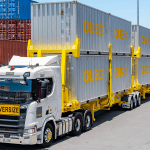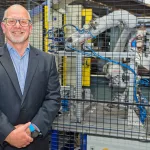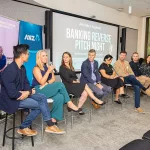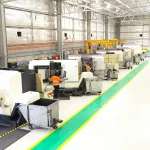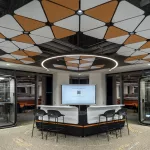“I come from a family of educators, and after a stint working in New York I moved back to California and joined my mother in a small software company that made products to use in schools.
“It was great experience being able to grow and build a family business for 10 years, and I left with a notion and feeling that I wanted to work with products that have a positive impact on people’s lives.”
Larry Nelson has been infatuated by technology ever since he was first exposed to computers in the mid-70s, playing Star Wars while at Woodside Priory School in the Silicon Valley.
Though formally educated in marketing and finance with an MBA from Cornell University, the 1990s defined his career path, the family business (Decision Development Corp.) pioneering products to replace textbooks and selling into 12 states across America.
Nelson now serves as Microsoft Asia’s Regional General Manager for Education. Having moved out to Singapore a little over a year ago, he has just celebrated a decade at the company and carries the same levels of energy as he did on day one.
“I was extremely fortunate to be able to join in the aftermath of the financial recession of 2008-2009, as Microsoft was still investing and looking to drive change in the sector,” he recalls.
“Today I am responsible for our education business across Asia, which is organised into five areas – India, Greater China, Japan, Australia and APAC which includes New Zealand and Korea. It is a wonderful challenge and I have a great team on the ground who are dedicated to making a difference.”
Technology, for Nelson and Microsoft, is the enabler of that difference.
For instance, the company recently teamed up with IDC to release a study on the impact artificial intelligence will likely have on Asia Pacific by 2021. The headline finding shows that AI will allow the rate of innovation and employee productivity improvements to nearly double, according to regional business leaders.
However, despite the fact 80 percent of participants said AI will be instrumental to their organisation’s competitiveness, only 41 percent have embarked on implementation.
Three key challenges were identified – a lack of thought leadership, a shortage in tools and infrastructure to develop actionable insight, and finally a deficit in skills, resources and continuous learning programmes.
It is this third challenge, centred around education, that Microsoft and its work with learning institutions can make a truly transformational impact.
“Technology adoption varies in each area we are in,” Nelson explains, speaking from Brisbane while waiting for a late night flight back to Singapore. “For example, in Australia we are doing some really innovative work around aboriginal language with the New South Wales Department of Education, using augmented reality. In New Zealand we have students using the computer game Minecraft to learn coding by building virtual worlds.
“While there are differences in how technology is used, what I see is a consistency in what we’re all trying to achieve – our aim is to prepare students for the next level and ultimately boost the economic potential of these places.”
Nelson’s team comprises around 150-170 people across the five main territories that make up Microsoft Asia’s education division. From state to city to national level, the firm strikes up close relationships with educational authorities in order to assess and then deliver the technology required to meet their needs.
This order of events is crucial to Nelson. “The first step for us is not technology-based,” he says. “It is vital we understand where their goals and objectives lie, and this can be achieved through workshops and development of education transformation frameworks.
“What are the school’s capacity to install technologies? What knowledge will we need to pass onto the teachers and build up? These are vital questions that must be examined, and the conversation about the type of technology comes quite late in the process. At the end of the day we want to build personalised, engaging ways for people to learn.”
PROJECT FOCUS: MALAYSIA
In Malaysia, Microsoft has helped transform the technology setup at Universiti Sains Islam (USIM), a fully federal government-owned Islamic university based in Negeri Sembilan with more than 12,000 students and 723 faculty members.
Course content, lectures and assignments are now managed from a central hub, and the university is also able to access updated curricula and experience faster resolution of IT challenges. Among the solutions adopted are Microsoft Imagine Academy, Office 365, Skype for Business and Microsoft Teams, the ultimate aim being to provide personalised, interactive experiences to its stakeholders and gather enriched data insight.
“USIM needed a digital transformation to deliver enhanced student outcomes while at the same time helping to contain costs and drive efficiency in their operations,” adds Nelson. “This is one of hundreds of examples of us working with schools and colleges of all kinds.”
LOOKING AHEAD
A challenge for Microsoft (and indeed any organisation influenced by digitisation) is to remain ahead of the curve regarding the speed of technological change.
For Nelson, working towards the same endpoint is vital in ensuring the organisation continues to facilitate positive transformation in education.
“Technology changes so quickly and in so many different ways,” he says. “My 30 years of experience have witnessed tremendous change but the core objective about driving the learning experience has remained the same. Whether it’s big data, AI, analytics, to me it’s all geared to the same goal.”
But what technologies will be the most transformative in years to come?
“There are many technologies and trends that will help redefine education,” he continues. “Data and analytics, AI, this idea of immersive learning; these are all tremendously exciting.
“We recently acquired DataSense, a solution in the US from a company called BrightBytes and something we envisage building into a platform in some way. Leveraging data was a key takeaway from our research with IDC, and DataSense is used by schools and educational authorities to gather information and report it to authorities.”
For example, causes of absenteeism and identification of at-risk students can be obtained from such solutions, the potential impact on individuals and schools clear to see if this analytical power is used appropriately.
This is just one of many developments constantly unfolding both through acquisition and internal development at Microsoft, a cause for great optimism for Nelson looking into the future.
“Absolutely I am optimistic,” he says. “I am very positive, excited and honoured to be part of a Microsoft that has huge potential to help unlock the massive talent base across Asia. Education will fuel our future and it is a joy to be a part of it.”
















